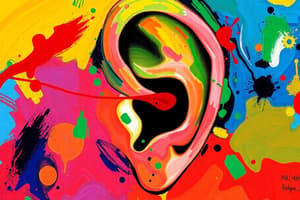Podcast
Questions and Answers
Betaxolol hydrochloric eyedrops have been ordered for a pt. with glaucoma. Which nursing action is most appropriate relating to monitoring for side/adverse effects of this medication?
- Monitor temp
- Monitor bp
- Assess peripheral pulses
- Assess blood glucose levels
Betaxolol hydrochloric eyedrops have been ordered for a pt. with glaucoma. Which nursing action is most appropriate relating to monitoring for side/adverse effects of this medication?
- Monitor temp
- Monitor bp
- Assess peripheral pulses
- Assess blood glucose levels
- Assess peripheral pulses
- Monitor temp
- Assess blood glucose levels
- Monitor bp (correct)
The nurse is preparing to give eyedrops. Which interventions should the nurse take? SELECT ALL
- wash hands
- put on gloves
- place drop in conjunctival sac
- pull the lower lid down against the cheek
- instruct the client the squeeze the eyes shut after instilling the eyedrop
The nurse is preparing to give eyedrops. Which interventions should the nurse take? SELECT ALL
- wash hands
- put on gloves
- place drop in conjunctival sac
- pull the lower lid down against the cheek
- instruct the client the squeeze the eyes shut after instilling the eyedrop
- pull the lower lid down against the cheek
- instruct the client the squeeze the eyes shut after instilling the eyedrop
- put on gloves
- wash hands
- place drop in conjunctival sac
The nurse prepares a client for an ear irrigation. Which action should the nurse take when doing this?
- Warm solution to 98.6
- position the pt with the affected side up following the irrigation
- direct a slow steady stream of irrigation solution toward the eardrum
- assist the pt to turn head so that the ear to be irrigated is facing upward
The nurse prepares a client for an ear irrigation. Which action should the nurse take when doing this?
- Warm solution to 98.6
- position the pt with the affected side up following the irrigation
- direct a slow steady stream of irrigation solution toward the eardrum
- assist the pt to turn head so that the ear to be irrigated is facing upward
- position the pt with the affected side up following the irrigation
- assist the pt to turn head so that the ear to be irrigated is facing upward
- direct a slow steady stream of irrigation solution toward the eardrum
- Warm solution to 98.6
To minimize the risk of systemic absorption of eyedrops the nurse should instruct the pt to do what?
- eat before instilling
- swallow several times after instilling
- blink vigorously to encourage tearing after instilling
- occlude the nasolacrimal duct with a finger after instilling
To minimize the risk of systemic absorption of eyedrops the nurse should instruct the pt to do what?
- eat before instilling
- swallow several times after instilling
- blink vigorously to encourage tearing after instilling
- occlude the nasolacrimal duct with a finger after instilling
A client is ordered an eye drop and ointment. IN what order should you give?
- Give eyedrop first followed by ointment
- ointment first, followed by drops
- eyedrop, wait 15 min, then ointment
- Ointment, wait 15 min then drops
A client is ordered an eye drop and ointment. IN what order should you give?
- Give eyedrop first followed by ointment
- ointment first, followed by drops
- eyedrop, wait 15 min, then ointment
- Ointment, wait 15 min then drops
Which medication for glaucoma should the nurse question?
- Betaxolol
- Atropine Sulfate
- Pilocarpine Hydrochloride
- Pilocarpine
Which medication for glaucoma should the nurse question?
- Betaxolol
- Atropine Sulfate
- Pilocarpine Hydrochloride
- Pilocarpine
A miotic medication has been ordered for a pt with glaucoma. The pt asks about this medication, what is an appropriate response?
- The med will help dialate the eye to prevent pressure
- It will relax the muscles of the eye & prevent blurred vision
- It causes pupil to constrict and will lower the pressure in the eye
- will help block responses that are sent to the muscles in the eye
A miotic medication has been ordered for a pt with glaucoma. The pt asks about this medication, what is an appropriate response?
- The med will help dialate the eye to prevent pressure
- It will relax the muscles of the eye & prevent blurred vision
- It causes pupil to constrict and will lower the pressure in the eye
- will help block responses that are sent to the muscles in the eye
A client admitted to rule out GI bleed. The pt is on many medications and states that they are hearing roaring sounds in the ears m especially when they are alone. What medication could cause this?
- Doxycycline
- Acetylsalicylic
- atropine sulfate
- diltiazem hydrochloride
A client admitted to rule out GI bleed. The pt is on many medications and states that they are hearing roaring sounds in the ears m especially when they are alone. What medication could cause this?
- Doxycycline
- Acetylsalicylic
- atropine sulfate
- diltiazem hydrochloride
IN prep for cataract surgery the nurse is to give cyclopentolate eyedrops. What are the characteristics of this medication?
- produces miosis of the operative eye
- dilate the pupil of the operative eye
- constricts the pupil of the operative eye
- provides lubrication to the operative eye
IN prep for cataract surgery the nurse is to give cyclopentolate eyedrops. What are the characteristics of this medication?
- produces miosis of the operative eye
- dilate the pupil of the operative eye
- constricts the pupil of the operative eye
- provides lubrication to the operative eye
Betaxolol hydrochloric eyedrops have been ordered for a pt. with glaucoma. Which nursing action is most appropriate relating to monitoring for side/adverse effects of this medication?
Betaxolol hydrochloric eyedrops have been ordered for a pt. with glaucoma. Which nursing action is most appropriate relating to monitoring for side/adverse effects of this medication?
The nurse is preparing to give eyedrops. Which interventions should the nurse take? SELECT ALL
The nurse is preparing to give eyedrops. Which interventions should the nurse take? SELECT ALL
The nurse prepares a client for an ear irrigation. Which action should the nurse take when doing this?
The nurse prepares a client for an ear irrigation. Which action should the nurse take when doing this?
To minimize the risk of systemic absorption of eyedrops the nurse should instruct the pt to do what?
To minimize the risk of systemic absorption of eyedrops the nurse should instruct the pt to do what?
A client is ordered an eye drop and ointment. In what order should you give?
A client is ordered an eye drop and ointment. In what order should you give?
Which medication for glaucoma should the nurse question?
Which medication for glaucoma should the nurse question?
A miotic medication has been ordered for a pt with glaucoma. The pt asks about this medication, what is an appropriate response?
A miotic medication has been ordered for a pt with glaucoma. The pt asks about this medication, what is an appropriate response?
A client admitted to rule out GI bleed. The pt is on many medications and states that they are hearing roaring sounds in the ears m especially when they are alone. What medication could cause this?
A client admitted to rule out GI bleed. The pt is on many medications and states that they are hearing roaring sounds in the ears m especially when they are alone. What medication could cause this?
In prep for cataract surgery the nurse is to give cyclopentolate eyedrops. What are the characteristics of this medication?
In prep for cataract surgery the nurse is to give cyclopentolate eyedrops. What are the characteristics of this medication?
Flashcards
How to administer two eye medications at the same time?
How to administer two eye medications at the same time?
Administer them 3-5 minutes apart to prevent one medication from diluting or flushing out the other before it can be absorbed.
Betaxolol eyedrops for glaucoma: What to monitor?
Betaxolol eyedrops for glaucoma: What to monitor?
Monitor the patient's blood pressure due to potential side effects like hypotension, dizziness, and fatigue associated with betaxolol.
Correct procedure for administering eye drops
Correct procedure for administering eye drops
Wash hands, put on gloves, place the drop in the conjunctival sac, and pull the lower lid down against the cheek to administer eye drops properly.
Ear irrigation: Solution temperature?
Ear irrigation: Solution temperature?
Signup and view all the flashcards
Minimize systemic absorption of eyedrops
Minimize systemic absorption of eyedrops
Signup and view all the flashcards
Eye drops and ointment: What order?
Eye drops and ointment: What order?
Signup and view all the flashcards
Glaucoma medication to question?
Glaucoma medication to question?
Signup and view all the flashcards
Miotics for glaucoma: How do they work?
Miotics for glaucoma: How do they work?
Signup and view all the flashcards
Medication causing roaring sounds in ears?
Medication causing roaring sounds in ears?
Signup and view all the flashcards
Cyclopentolate eyedrops before cataract surgery: Effect?
Cyclopentolate eyedrops before cataract surgery: Effect?
Signup and view all the flashcards
Study Notes
- When administering two different eye medications, wait 3-5 minutes between instillation.
Betaxolol Hydrochloride Eye Drops
- Monitoring blood pressure is crucial due to potential side effects like hypotension, dizziness, nausea, diaphoresis, headache, fatigue, constipation, or diarrhea.
Administering Eye Drops
- Key steps include:
- Washing hands
- Donning gloves
- Placing drops in the conjunctival sac
- Pulling the lower lid down against the cheek.
- Avoid squeezing eyes shut after instillation.
Ear Irrigation
- Use a solution warmed to 98.6°F (37°C) to prevent injury, nausea, or vertigo.
- Inspect the tympanic membrane before irrigating to ensure that it is intact.
Minimizing Systemic Absorption of Eye Drops
- Occlude the nasolacrimal duct with a finger after instilling eye drops.
Eye Drop and Ointment Administration Order
- Administer eye drops first, followed by the ointment after a 3-5 minute interval.
Glaucoma Medication - Contraindications
- Question the use of atropine sulfate, as it is a mydriatic that dilates the pupil and can increase intraocular pressure.
Miotic Medications for Glaucoma
- These medications constrict the pupil to lower intraocular pressure, increasing blood flow to the retina and reducing retinal damage and vision loss.
Ototoxic Medications
- Acetylsalicylic acid (ASA) should be questioned in a client being evaluated for a GI bleed who reports hearing "roaring sounds" in the ears, as it can be ototoxic and is contraindicated in GI bleeds.
Cyclopentolate Eye Drops for Cataract Surgery
- Cyclopentolate eyedrops dilate the pupil of the operative eye, with accommodation returning in 6-24 hours.
Studying That Suits You
Use AI to generate personalized quizzes and flashcards to suit your learning preferences.




